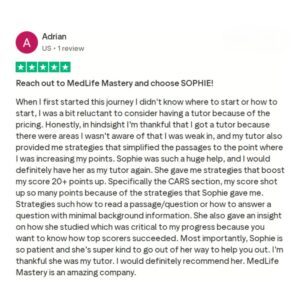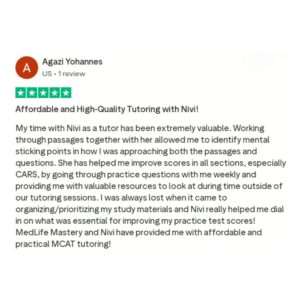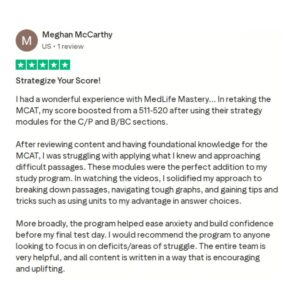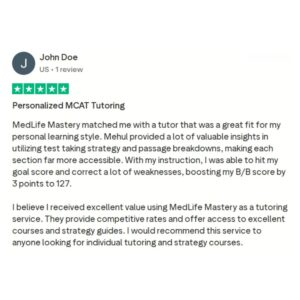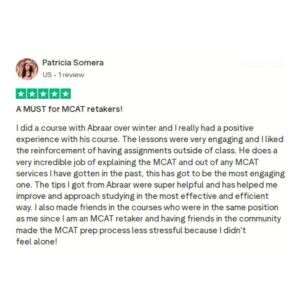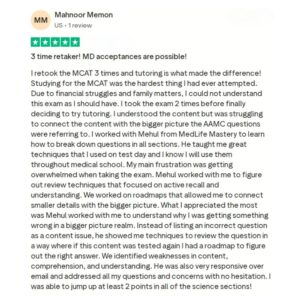Studying and preparing for the MCAT wouldn’t be complete without practice and answering MCAT practice questions. Answering practice questions allow you to apply what you have learned in relevant situations.
At the same time, they make you feel confident so that you know the format and structure of the questions (and answers) on your MCAT exam day.
This article will provide a few MCAT sociology practice questions you can answer as you prepare and study for the MCAT.
If you want to assess your MCAT sociology knowledge and skills to know whether or not you are ready to take the MCAT, please keep reading.
What is MCAT Sociology?
Sociology is a field of study that concentrates on society, human social behavior, social interaction patterns, and aspects of daily life-related culture. It creates a corpus of knowledge on social order and social change using various techniques for empirical study and critical analysis.
Since the connection between social structure and individual agency affects all facets of human activity, including health and the institution of medicine, the military, the economy, control systems, and punishment, sociology has gradually expanded its focus to include other topics and institutions.
The medical profession regards sociology as crucial knowledge that aspiring doctors must possess to deliver the best treatment to a diverse patient population and understand how social interactions affect health, which is why it is included in the MCAT.
Sociology makes up 30% of the psych/soc portion of the MCAT. This suggests that 18 of the 59 test questions include sociological information.
Sociology Topics to Study for the MCAT
There are many different aspects of sociology; not all of them will be assessed on the MCAT. As you prepare for the MCAT, you must familiarize yourself with the topics it will cover.
To help you save time in researching these subjects, we have supplied a list of them below.
MCAT Sociology Practice Questions
Answering practice tests and questions is one of the best and most effective ways to achieve a strong MCAT score. You just do not go taking the MCAT without answering them. They serve as your MCAT ‘rehearsals.’
We are here to support you on your MCAT journey, and for your benefit, we have a few MCAT sociology practice questions for you to answer. Good luck!
1. What among the following is NOT an instance of discrimination?
A. All new patients are questioned regarding safe sex practices, drug and alcohol usage, and smoking.
B. Entire streets of Chinatown were placed under quarantine because it was believed that Chinese people were carriers of the bubonic plague.
C. Patients in wheelchairs must be directed to other locations for their care because the outpatient clinic lacks a wheelchair ramp.
D. The clinic made the decision to test for chlamydia in all Medicaid patients, but not in private-payer patients because it appeared unnecessarily expensive to test everyone.
2. The following are social institutions, with the EXCEPTION of:
A. families
B. schools
C. churches
D. social networks
3. Joy lives in a community where 40% of the residents are obese. Nearly half of the adults in her area are food stamp recipients and unemployed. Within ten blocks of Joy's home, there are no grocery stores but lots of fast-food restaurants. The community around Joy is in the following socioeconomic conditions:
I. a food desert
II. extreme poverty
III. relative poverty
A. I only
B. II only
C. I and II
D. I and III
4. A nation with a profit-driven, privately owned economy but state-funded public services like healthcare and education would be seen as:
A. socialist
B. capitalist
C. collectivist
D. welfare capitalist
5. According to a study, low-income Hispanic women who live in an urban area close to an industrial facility are more than twice as expected to have a rare form of cancer as women in general. The potential causes of this discovery include all of the following, EXCEPT:
A. unfairness in the environment
B. inequities in healthcare based on class
C. disparities in healthcare based on gender
D. inequalities in healthcare based on ethnicity
6. The driving prowess of a group of men and women will be evaluated. The experiment emphasizes the role of gender, and the results show that women do worse than men. In a different experiment, gender is not a factor and the ratings for the two groups are comparable. Which concept are these findings consistent with?
A. prejudice
B. threat from stereotypes
C. institutional discrimination
D. the just-world hypothesis
7. All of the following socializing techniques MAY be used by adult prison systems to attempt to alter the conduct of inmates, EXCEPT:
A. resocialization
B. primary socialization
C. secondary socialization
D. anticipatory socialization
8. Which of the following circumstances most accurately sums up belief perseverance?
A. A person changes her mind after hearing a convincing argument
B. After hearing an argument opposing a belief, a person maintains their belief.
C. Members of a group have a propensity to steadfastly adhere to their personal beliefs.
D. When one initially knows nothing about a subject, they believe the most compelling argument
9. The connections involving clients and personal injury lawyers are being studied by a sociologist. She looks at how wealthy, successful, white attorneys and their clients interact with immigrant families. Because the clients and attorneys have varying degrees of money and prestige, the sociologist aims to concentrate her investigation on these issues. Which sociological framework would be most appropriate for this analysis?
A. functionalism
B. conflict theory
C. symbolic interactionism
D. norm deviance dynamics
10. Sociologists have discovered that compared to white nation populations, health outcomes and healthcare disparities for first-generation immigrants from West African countries are relatively minor; however, for the children of West African immigrants, these factors are almost identical to those experienced by African Americans who were born in the United States. This brief decline in a single generation is probably due to:
A. irrespective of educational attainment
B. social segregation into ethnic conclaves
C. a deeper fusion of social and cultural practices with American culture
D. lifelong exposure to the U.S.'s greater socioeconomic environment compared to West African countries
11. A woman walking along a city sidewalk drops the huge shopping bags she is carrying after slipping on some ice. Which of the following scenarios has the most likelihood of the woman getting assistance?
A. The slip happens during rush hour in the morning.
B. The sidewalk is located in a mixed-use neighborhood in a suburban location.
C. There was only one person on the sidewalk when the woman slipped, and it was otherwise empty.
D. She slips while walking down a crowded metropolitan boulevard with a large number of people nearby.
12. When a teacher asks a pupil to quit obstructing other students in class, the pupil adjusts his behavior. Which of the following sums up this shift in behavior the best?
A. obedience
B. conformity
C. social loafing
D. bystander effect
13. An emergent public health issue is the topic of a task force made up of executives from several industries within a large economy. This group is most appropriately described as:
A. out-group
B. primary group
C. secondary group
D. reference group
MCAT Sociology Sample Passage 1
CRISPR-Cas9 may allow for the modification of a person's genetic code. Several ethical questions have consequently been raised. Is it moral to change a human embryo's genetics, for instance? There is a group of scientists assembled to assess the CRISPR-Cas9 technology's ethical implications. Before the meeting, every scientist there agreed that the technology could be incredibly useful as an investigative tool but expressed considerable caution and skepticism about its widespread application in therapeutic settings.
Each of the two groups of scientists is tasked with developing a scientific policy recommendation. Group 1 is shown a movie that graphically illustrates the risks of genome editing prior to considering a new policy recommendation. There is no time constraint for Group 1 to make a choice. Group 2 is shown a film from the American president, on the other hand highlighting the urgency with which they must make a decision and is given an hour to do so.
The teams are requested to share their research the evening after the exercise. Group 1 provides a policy that completely rejects CRISPR-Cas9 technology and claims that its potential drawbacks vastly outweigh its advantages. The unoriginal idea presented by Group 2 is that regulatory restrictions should only be introduced as issues emerge.
14. Which one of the following statements most accurately sums up how Group 1 came to their policy recommendation?
A. groupthink
B. social loafing
C. bystander effect
D. group polarization
15. Which of the following accurately sums up the process Group 2 used to develop its policy recommendation?
A. groupthink
B. social loafing
C. bystander effect
D. group polarization
16. The policy advice in Group 1 is originally rejected by a scientist, who later accepts it after realizing that she is outnumbered. This is an illustration of:
A. obedience
B. conformity
C. socialization
D. social facilitation
17. What among the following does NOT serve as a socializing agent?
A. media
B. peers
C. hunger
D. family
MCAT Sociology Sample Passage 2
Many social activities rely on social institutions to be carried out. Education, family, government, religion, the economy, and healthcare are just a few examples of these institutions. Researchers looking at how socioeconomic status (SES) impacts education and vice versa chose to examine school systems across the US.
Two parallels amongst educational systems were discovered by the researchers through a variety of observational, cross-sectional, and longitudinal investigations. First, the researchers discovered an educational "hidden curriculum" that teaches kids more than the arithmetic and literary criteria required to advance between grades. The unintended consequence of education is that it teaches children about societal norms.
The second finding was that students' performance was influenced by the teacher's expectations of their performance. Researchers performed an observational study in which they first assessed a teacher's expectations for each student in a classroom using a standardized rubric in order to explore this effect in greater depth. The pupils' performance on the state-required standardized test was then measured by the researchers in terms of percentile performance. Researchers discovered that kids who had teachers that held them to high standards for achievement outperformed their peers on exams. However, children who had teachers who had low expectations for their accomplishments underperformed compared to their peers on exams.
18. Which of the following best describes the concealed curriculum?
A. latent role of the family
B. obvious role of the family
C. clear purpose of education
D. latent educational function
19. What impact do the findings of the observational study mentioned in the previous paragraph have on the teacher expectancy theory?
A. Weaken because the kids with high expectations from their teachers do well on the test
B. Strengthen because the kids with high expectations from their teachers do poorly on the test
C. Weaken as a result of the exam results of the pupils with high expectations from their teachers
D. Strengthen because students with high expectations from their professors do well on exams
20. Researchers have chosen to experimentally measure test results at a particular point in time for a new study. The classification of this recent study is:
A. a longitudinal study
B. a case-control study
C. an observational study
D. a cross-sectional study
Answer Key:
1. A | 11. C |
2. A | 12. A |
3. D | 13. C |
4. D | 14. A |
5. C | 15. A |
6. B | 16. A |
7. B | 17. C |
8. D | 18. D |
9. B | 19. D |
10. C | 20. D |


 To help you achieve your goal MCAT score, we take turns hosting these
To help you achieve your goal MCAT score, we take turns hosting these 



